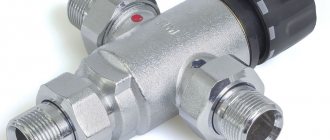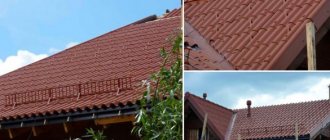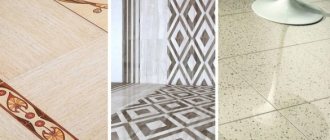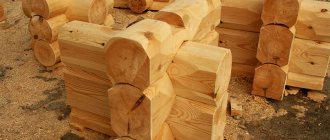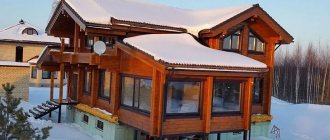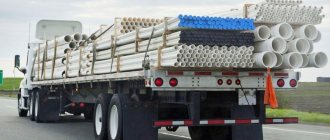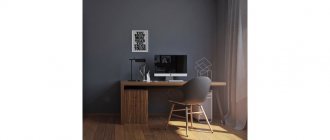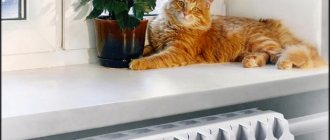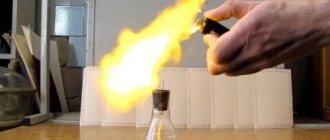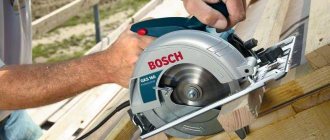Painting interlining is the name of a group of non-woven interlining paper-like materials, which are based on sized and unglued, modified and unmodified cellulose fibers.
Painting interlining is a smooth non-woven product that is obtained by combining long-fiber cellulose and polyester fibers from textiles with a polymer acrylic fusion. Non-woven threads resemble fiberglass, but they are much thinner.
This fact is the basis for creating a smooth and thin coating of non-woven canvas.
Non-woven canvas for painting - features of choosing the material and working with it
Anyone who has ever dealt with renovation work knows how difficult it is to achieve a perfectly smooth surface, especially if it will be painted. Paint can radically change a room, but at the same time, if there are flaws on the surface, they will be visible to the naked eye.
This is why non-textured non-woven painting linen for painting is so popular - with its help the surface becomes perfectly smooth.
Non-woven fabric is very similar to fiberglass, but these are completely different materials
Overview of the main features of the material
To understand the features of working with non-woven coating for painting, you need to understand what this material is and what criteria high-quality samples must meet.
Manufacturing technology
Non-woven paper for painting consists of the following main components:
- The basis is long-fiber cellulose - a durable and reliable material.
- The top layer is made of the finest polyester fibers, thanks to which the surface is so smooth and durable.
- The binding component is a polymer acrylic composition, which gives the coating a lot of positive properties: lack of linear expansion, resistance to humidity and temperature changes and a very long service life.
The surface of the coating resembles a drawing paper, but its structure is much smoother and softer. This coating is suitable for any room, it is completely environmentally friendly and does not emit any harmful substances during operation. That is why it can be used even in children's rooms, kitchens and bathrooms. .
Criterias of choice
High performance properties of this type of finish can only be guaranteed when the material is made from high-quality raw materials and in compliance with numerous standards.
It is quite simple to distinguish a high-quality product from a low-quality one:
- The main indicator of quality is a perfectly smooth, silky structure. Any extraneous inclusions, irregularities and other defects indicate that the product was manufactured in violation of technology. It is from the surface that you should start choosing the optimal option.
- Leading manufacturers pay great attention to the ideal processing of edges, since these are the most problematic areas - flaws and tears significantly worsen the appearance of the surface.
- Another indicator of high quality is the elasticity of the material; if there are traces of bending on it, it is better to choose another sample that is more resistant to damage.
- The composition should not contain any foreign additives. To ensure this, you need to ask the seller to provide a quality certificate. If it is not available, it is better to refuse the purchase, since all products in this group must undergo certification.
- Another important factor is the lack of stretch in any direction. It is very simple to check this; you need to pull any section of the material in different directions; if it is even slightly stretched, its strength is quite low.
Unlike fiberglass, construction non-woven fabric for painting is almost opaque; any visible fibers are a sign of low quality
Advice! It is best to choose products from well-known brands or read reviews about a particular material on construction forums on the Internet. As a rule, the necessary information can be found fairly quickly.
Conclusion: so which is better?
It can be quite difficult to make an unambiguous conclusion regarding which wallpaper is better: non-woven or vinyl. To make the right choice, it is worth conducting a comparative analysis to determine the feasibility of using one or another option. In some cases, personal preference is the main selection criterion. Those who value the environmental friendliness of the material should avoid vinyl wallpaper. In addition, please remember that:
- Non-woven strips are breathable, but vinyl strips are not;
- Non-woven fabric is easy to install, without creating difficulties when gluing walls;
- Vinyls are presented in a large assortment. You can always choose a canvas with a suitable design, taking into account the square footage and purpose of the room being decorated;
- The vinyl surface is easier to clean and is not afraid of exposure to moisture, fire, or ultraviolet radiation. Resists mechanical stress well. It costs less than non-woven fabric.
Which type is preferable, everyone must decide for themselves. Non-woven and vinyl wallpaper can be used to decorate walls in different rooms. When making a choice, you need to know the conditions of subsequent operation
Features of the work
To achieve a positive result, just purchasing good material is not enough; it is important to carry out all the work in accordance with the technology. In fact, everything is quite simple, but you should still remember the basic rules.
Preparatory stage
At this stage, you should first prepare all the necessary materials:
- Sufficient amount of non-woven covering with a small margin just in case.
- Glue for non-woven coverings, and remember that its consumption will be slightly higher than when working with wallpaper coverings.
The price of good glue, as in the photo, is quite high, but in no case is it worth saving on it
- If the surface to be finished has uneven surfaces, they should be repaired using putty; it is best to choose an acrylic composition.
- To level the material when gluing sheets with your own hands, it is better to use a special spatula.
Using this device it is very convenient to smooth the surface and expel air from under the material
Next, the surface should be prepared; within this stage, the following work is carried out:
- All debris and dust must be removed. After this, the wall or ceiling to be finished is carefully inspected for damage and flaws.
- If there are uneven surfaces, they must be repaired using putty. After it dries, it is necessary to sand it using a special block with replaceable sanding sheets.
Important! If you are going to cover a wall finished with plasterboard, then you need to putty all the seams and fastening points. In this case, it is recommended to use fiberglass mesh on the seams for additional protection against cracking.
Leveling the plasterboard surface is very simple
- The last type of work is priming the surface; any deep penetration composition is suitable for this.
Carrying out work
Even many experienced builders do not know what the technology is - painting non-woven fabric for painting did not exist a decade ago.
But the work is quite simple, they are somewhat reminiscent of wallpapering, but there are some features:
- First of all, the adhesive composition is prepared, this is done as recommended by the instructions on the package.
- Remember that the solution should not be applied to the material itself, but to the surface to which it will be glued. The easiest way to do this is with a special brush.
- It is better to carry out gluing with an assistant; first, the sheet is carefully applied to the surface, after which it is leveled using a spatula. The next sheet is located nearby, with special attention should be paid to the joints. Due to the fact that the material does not stretch, leveling the surface will not be difficult.
It is more difficult to glue interlining for painting on the ceiling than on the walls
- After finishing the work, the surface should be allowed to dry for at least a day, or better yet, wait a few days, after which you can apply paint. Additional puttying of the surface is not required; this distinguishes interlining from fiberglass.
After painting, the result is a perfectly smooth, pleasant-to-touch surface.
Almost any paint is suitable for painting. If there are metal elements on the surface, then they should also be painted; fire-retardant paints for metal Polistil are well suited; they, like non-woven fabric, do not support combustion and significantly increase the level of fire safety of the room.
How to glue non-woven canvas
Non-woven canvas is a non-woven fabric made of cellulose and textile fibers with a polymer binder. Outwardly, it is somewhat similar to fiberglass, but has a smoother surface. It is used primarily as a leveling layer for painting, wallpaper, plastering, etc.
Tools
Materials
The material has high tensile strength, which allows it to be used as a reinforcing layer on walls and ceilings. It not only hides cracks, but also prevents them from developing further. The canvas maintains dimensional stability when wet and dry and is highly breathable. This means that the surface underneath will “breathe” and will not become moldy even in high humidity conditions.
Non-woven canvas hides defects in the base well, but for this it is necessary to strictly follow the gluing technology.
The basis for non-woven canvas can be concrete (plastered, painted and even covered with wallpaper), plywood, chipboard, MDF, plastic, etc. It is important that the surface is clean, durable, dust-free and dry.
In difficult cases, for example, when finishing old walls with a mineral coating, pre-treatment with a reinforcing primer such as “concrete contact” is recommended.
To work, you need thick, high-quality glue for heavy wallpaper. The composition is applied directly to the wall, after which the canvas is applied to it,
level it vertically using a level or plumb line, press tightly and expel air bubbles formed under the surface.
The canvases are glued end-to-end, and the excess, which may occur at the boundaries with the floor and ceiling, as well as near door and window openings, is cut off with a sharp knife.
Next, all windows and doors in the room should be closed to prevent drafts, and left in this state for at least a day.
After the glue has completely dried, you can begin finishing - painting, plastering, wallpapering, etc.
Since non-woven fabric has a durable, wear-resistant surface, decorative coatings can be applied to it repeatedly. The material can withstand dozens of repaintings. If you need to remove previously pasted wallpaper, this can be done without damaging the canvas.
Compound
In the production of non-woven material, artificial fibers are used. The main composition of the interlining fabric is viscose. Since the material is non-woven, it does not have a transverse or longitudinal thread, however, craftswomen prefer to cut the reinforcing fabric lengthwise, since it stretches slightly in the transverse direction. According to GOST, adhesive interlining fabrics are marked like other fabrics. That is, the manufacturer must indicate the composition and care rules.
The paper-like substance is considered semi-synthetic. That is, cellulose fibers are diluted with polyester. However, 100% viscose varieties are also available on sale. By chemically modifying the fibers, it is possible to increase strength and wear resistance. Rigid modifications are characterized by high dimensional stability, are well painted and retain color, and are resistant to dirt.
Painting non-woven fabric: characteristics and application
Painting non-woven material is a non-woven material similar to fiberglass, but has a much finer structure, due to the fact that it is made of glued and unglued, modified and unmodified cellulose and textile fibers with polymer binders.
Non-woven threads resemble fiberglass, but they are much thinner. Painting non-woven fabric or non-woven canvas is characterized by the presence of a smooth surface.
Non-woven canvas has become a good replacement for the “cobweb” - painting fiberglass. Non-woven fabric is used when renovating apartments, offices and other premises where it is necessary to ensure durability and wear resistance.
Painting non-woven fabric is an environmentally friendly material. It does not contain PVC, allows moisture to pass through like paper wallpaper, is difficult to ignite, and is therefore considered fireproof.
When choosing, pay attention: non-woven fabric should not stretch, the texture should be perfectly smooth and soft, and particles of foreign origin should not appear on it. The edges should be smooth and the material should have increased elasticity.
Another important advantage of the material is its tensile strength. Non-woven canvas ideally hides defects in treated surfaces, restrains and prevents small and thin cracks in the wall, and serves as a kind of reinforcing material.
Non-woven fabric does not stretch, will not shrink when wet, does not deform and does not change the structure when re-wetting and subsequent drying.
Non-woven canvas adheres firmly to almost any surface. This could be crumbling plaster, drywall, the base of old wallpaper or old paint that cannot be removed; plastic or fiberglass, wooden boards or chipboard.
All types of materials are subject to the same requirements for the conditions for gluing the canvas - the surface must be neutral in color, uniform, dry, smooth and even.
Painting non-woven fabric has surface stability, which allows decorative coatings to be applied repeatedly. When carrying out repeated repairs, it is not difficult to remove the wallpaper glued to the material. The interlining itself is not damaged.
Canvas can be pasted over multiple times. A similar situation is with painting walls. If the painting interlining has been painted, it can be repainted regularly. At the same time, having decided to carry out a major overhaul or create another surface covering, the master can easily dismantle the non-woven canvas. It is removed dry.
The material is easy to stick to the surface to be treated. Wallpaper glue is applied directly to the wall, after which the painting non-woven fabrics are applied dry to the surface treated with glue. You can easily and accurately adjust the strips relative to each other. When gluing non-woven canvas onto the surface of the walls, it can be easily smoothed and straightened, even if it was stored deformed in a roll.
This technology of gluing the material guarantees economical consumption of wallpaper glue and time for work.
Before gluing the canvas, it is necessary to prepare the base. Depending on its type, it can be putty, crack reinforcement, etc.
After processing and cleaning, the painting non-woven fabric is glued using a thick wallpaper compound. Sheets of painting non-woven fabric are placed plumb and end-to-end in a thick layer of glue, then pressed.
Excess at the joints of the floor, ceiling, window or door openings is cut off with a sharp knife. After drying, wallpaper is glued onto the non-woven canvas, dispersion paint or other decorative material is applied.
Details
What adhesive composition to use
If you do not want to re-glue the ceilings several times, then you should immediately buy a special adhesive composition at a hardware store or on the market in order to get excellent gluing of non-woven wallpaper. If you use a starch custard composition, it will not hold such heavy fabrics. As a result, you will simply ruin the ceiling wallpaper, and you will never be able to glue it to the ceiling.
The special adhesive composition is very viscous and thick, so that the wallpaper for painting quickly begins to set and adheres perfectly to the ceiling surface. It must be applied directly to the ceiling surface, and then carefully apply the wallpaper for the ceiling and align it end-to-end with the previous strip. Usually the mixture is sold in dry form, and at home you will dilute it yourself with water before starting repair work for a short period of time and the adhesive composition will be ready.
We suggest taking a closer look at how to prepare it:
- You will definitely need a container with a wide neck. Most often, a simple bucket is used for this. Next, you need to read the instructions, how much water is needed for this amount of dry mixture and pour exactly this amount into the bucket.
- Take a large spoon and make a swirl in a bucket containing water, stirring the water. Next, carefully pour the mixture into it. It should be mixed evenly with water, there should be no lumps, otherwise lumps will appear when the wallpapering of the ceiling is finished.
- After ¼ hour, take the solution and stir it thoroughly, and that’s it, the composition is ready!
Previously, it was generally accepted that ceilings must be whitewashed and nothing else, since the walls will breathe well and the microclimate of the room will be the most favorable. At the moment, there are many materials on the market, as well as non-woven wallpaper on a rigid and strong base. If you use them to correctly decorate the ceiling, then if you wish, you will not have to think about major repairs for several years.
Tools and materials
Such tools are ideal for your work and you won’t need the rest. Before gluing, you need to go to a construction supermarket and you will find everything you need there.
Advantages of smooth painting non-woven fabric
Painting non-woven material glued to the walls or ceiling creates a perfectly smooth surface; it allows you to avoid spending a lot of time carefully leveling the base, which significantly saves time and money when carrying out repairs. In terms of performance characteristics, the material has a number of advantages compared to other finishing coatings.
- Reinforces the surface, preventing small cracks from growing and preventing the appearance of new cracks.
- Does not cause allergies, does not contain harmful solvents, heavy metal compounds, PVC, or plasticizers.
- Wallpaper "breathes". In accordance with DIN 52615, the vapor permeability coefficient of Erfurt non-woven fabric is equal to an air layer thickness of 0.02 m.
- Refers to low-flammable (G 1), moderately flammable (B 2) materials.
- If necessary, it can be easily removed from the wall when dry.
- Resistant to abrasion, has a high tensile strength.
- Non-woven fabric does not stretch when wet and then dries, but it has plasticity, following the contours of uneven walls.
Smooth repair interlining is a popular material among builders. A smooth surface allows you to reduce the consumption of glue and paint. This material can be used to cover walls in any premises, including children's and medical institutions. This is a durable coating. With proper use, the service life exceeds 15 years. Non-woven fabric can be repainted many times, forgetting about major repairs for many years.
Vinyl wallpaper is a popular type of moisture-resistant wall decoration
Vinyl wallpaper is a relatively new and quite popular type of decorative finishing of premises. Thanks to the wide range, vinyl coverings can be used everywhere.
Vinyl wallpaper comes in different types.
- Foamed vinyl coverings.
- Silkscreen printing.
- Washable wallpaper.
- Wallpaper with hard vinyl.
Using foam coating and subsequent embossing, you can imitate fabric, paper, wood, leather, decorative plaster, natural stone, stucco and other finishing materials.
All types of vinyl coverings have a common drawback - air tightness, which consists in the accumulation of excess moisture under the wallpaper, creating favorable conditions for the spread of fungus and harmful microorganisms. Therefore, experts consider it undesirable to use vinyl finishing in the bedroom, children's room and living areas where family members stay for a long time. At the same time, vinyl wallpaper is indispensable for decorative wall decoration in rooms with an increased risk of mechanical external damage and where there is often a need for thorough wet cleaning (in the kitchen, bathroom, hallway). Due to the exceptional water resistance of vinyl, wallpaper can be washed using detergents and a brush.
Modern wallpaper with micropores between vinyl embossing. They can be used in any living room. When repairing, it is recommended to use adhesives with antifungal additives.
Application of repair non-woven fabric
The most popular are 2 options for using smooth painting non-woven fabric.
- As a base for interior finishing material (decorative plaster or wallpaper, which must be glued to a flat, prepared base). The canvas perfectly levels and reinforces the surface, hides seams, defects in walls and ceilings, and masks color contrasts of the base. As a substrate, a material with a density of 85 to 200 g/m2 is used, depending on the severity of the facing material.
- Thick non-woven fabric from 120 g/m2 is used as a finishing coating for painting, since it will be repainted many times and must be durable. If you plan to decorate the walls with high-gloss paint, choose a material with a pigmented top layer.
Top 9 manufacturers of wallpaper for walls
| Photo | Name | Rating | Price | |||
| Budget options | ||||||
| #1 | Rasch | ⭐ 4.95 / 5 7 — votes | Find out the price | |||
| #2 | Marburg | ⭐ 4.9 / 5 3 - votes | Find out the price | |||
| #3 | Palette | ⭐ 4.85 / 5 7 — votes | Find out the price | |||
| #4 | Lutece | ⭐ 4.8 / 5 1 - voice | Find out the price | |||
| #5 | Grandeco | ⭐ 4.75 / 5 1 - voice | Find out the price | |||
| Wallpaper at medium and high prices | ||||||
| #1 | Andrea Rossi | ⭐ 4.95 / 5 1 - voice | Find out the price | |||
| #2 | Loymina | ⭐ 4.9 / 5 | Find out the price | |||
| #3 | Casa Mia | ⭐ 4.85 / 5 | Find out the price | |||
| #4 | Aura | ⭐ 4.8 / 5 3 - votes | Find out the price | |||
What would you choose or recommend?
Take the survey
Stages of work on gluing and painting smooth painting non-woven fabric
Smooth painting non-woven material is a universal material that can be glued to concrete, plastered, monolithic, and plasterboard surfaces. It is necessary to strictly follow the instructions for gluing and painting, because the durability of the coating depends on this. The work is carried out in several stages.
Preparing the base
- Remove remnants of old wallpaper, dust, dirt.
- Smooth out significant defects with putty containing gypsum.
- On highly absorbent substrates, apply a solvent-free primer.
Gluing smooth painting non-woven fabric
- Cut the wallpaper into sheets with a small margin (3-5 cm).
- Spread the wall with pre-diluted glue.
- Glue the interlining end-to-end, starting from the window, having previously marked the vertical with a plumb line.
- Smooth out the bubbles with a soft rubber roller or wallpaper brush, moving from top to bottom and from the middle to the edges.
- Trim excess wallpaper near the window, ceiling and floor using a sharp mounting knife and a wallpaper spatula.
Start painting the smooth repair non-woven fabric when the wallpaper glue has dried, no earlier than after 1-2 days. The paint is applied in 2 layers. Between layers, leave an interval for the coating to dry for at least 1-2 hours, depending on the composition of the paint and the temperature in the room.
If the wallpaper was previously painted with dark paint, then first carry out preliminary painting, and then apply the finishing coat of paint. Corners and joints are painted with a thin brush. The main surface is painted with a roller or spray, depending on the paint used.
To decorate walls and ceilings, choose water-based, acrylic or latex paints that do not contain solvents, as they can damage the material. Rooms painted with soft pearl or satin sheen can look especially impressive.
Advice! It is better to carry out all work with the windows closed and at a room temperature of 18 to 25 0 C and humidity up to 70%. This mode will help the glue and paint dry quickly, and will also help to avoid swelling and peeling of the wallpaper.
How to choose non-woven fabric
Smooth painting non-woven fabric has many advantages. It is a strong, easy-to-use material, practical and durable material if it is manufactured with strict adherence to all technological processes. When choosing, you need to pay attention to the quality of the repair non-woven fabric.
- The surface must be smooth, perfectly flat, without inclusions or flaws.
- The canvas cannot be transparent, as it is used as a basis for subsequent work.
- Smooth edges without tears or wrinkled areas are a sign that this is a premium class coating.
- Elasticity of the material. When slightly bent, there should be no traces of creases on it.
- Elasticity. When trying to slightly stretch the fabric, there should be no stretch marks left on it.
If it is not possible to check the quality of the offered non-woven fabric, we recommend choosing Erfurt non-woven fabric. Non-woven fabric produced in Germany under the Erfurt brand is a high-quality material that meets all kinds of standards and requirements.
Smooth painting non-woven fabric allows you to make the walls and ceiling absolutely smooth in the shortest possible time. It helps to quickly make repairs and save money. The material is widely used by private customers, construction companies, architects and designers due to its versatility and ease of use. It is used to decorate the interiors of houses, offices, new buildings, kindergartens and schools.
Which ones have more design options?
When choosing between vinyl and non-woven, you should pay attention not only to the service life and smoothing out wall unevenness, but also to the appearance. After all, in the end, coloring affects the final result of finishing work.
Non-woven fabrics are not distinguished by a variety of design finds. Most of the canvases are plain and smooth. A relief structure is achieved using foaming, but working with such a texture is not very convenient. But the drawings turn out to be deep: after all, they are not applied to the surface, but are obtained as a result of mixing colored fibers.
Vinyl wallpaper, due to the manufacturing method, is considered more diverse. They can be covered with ornaments, have a relief on the surface or imitate various textures (leather, wood, brick, concrete). The color palette is also extensive: from monochrome or pastel to bright, deep, rich shades.
Of the two options (vinyl or non-woven), the first has more possible design options.
